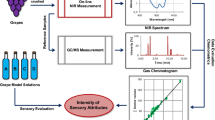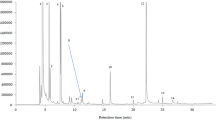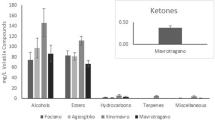Summary
The aroma of wine consists of 600 to 800 aroma compounds from which especially those, typical for the variety, are already present in the grapes. The aroma extracts — received by extraction with trichlorofluoromethane — are separated by gas chromatography. There are significant varietal differences between the aromagrams (“fingerprint pattern”). Thus the amount of some flavour compounds (“key substances”) shows typical dependence on the variety. Especially monoterpene compounds play an important role in the differentiation of wine varieties.
The German white wines can be differentiated into three groups only by quantitative determination of 12 monoterpenes (“terpene profile”). These groups are: “Riesling type”, “Muscat type” and “Silvaner-Weißburgunder type”. Such “terpene profiles” are also useful for the separation of real Riesling wines from others called Riesling (e.g. Welschriesling, Kap Riesling, Emerald Riesling) but not produced from grapes of the variety Riesling. Including further components and by means of statistical methods as for example linear discriminant analysis even the different varieties within the mentioned groups (for instance the “Riesling”-group: Riesling, Kerner, Ehrenfelser, Bacchus, Müller-Thurgau) can be separated from each other.
To identify compounds causing “off-flavours” the sniffing technique is the method of choice. The off-flavour is pinpointed during gas chromatography separation of the complex aroma mixture by effluent sniffing. Once allocated, the chemical nature of the off-flavours is elucidated by spectroscopic methods. Substances contributing to the green pepper taint, the strawberry note, mousiness, corkiness etc. in wine could be found in this way.
Similar content being viewed by others
References
Rapp A, Mandery H (1986) Experentia 42:857–966
Boeckh J (1972) Die chemischen Sinne — Geruch und Geschmack. In: Gauer OH, Cramer K, June (eds) Handbuch Physiologie des Menschen. Urban und Schwarzenberg, München
Guadagni DG, Buttery RG, Okano S (1963) J Sci Food Agric 14:761–765
Demole E, Engist P, Ohloff G (1982) Helv Chim Acta 65:1785–1794
Bayer E (1958) Vitis 1:298–312
Drawert F, Rapp A (1968) Chromatographia 1:446–457
Schreier P (1979) CRC Crit Rev Food Sci Nutr 12:59–111
Van Straten S, Maarse H (1983) Volatile compounds in food qualitative data. Div. for nutrition and food research TNO
Rapp A (1988) Wine aroma substances from gas chromatographic analysis. In. Linskens HF, Jackson JF (eds) Wine Analysis. Springer, Berlin Heidelberg New York, p 29–66
Rapp A, Knipser W, Engel L (1980) Vitis 19:226–229
Rapp A, Knipser W (1979) Vitis 18:229–233
Rapp A, Mandery H, Ullemeyer H (1984) Vitis 23:84–92
Rapp A, Mandery H, Güntert M (1984) Terpene compounds in wine. In: Nykänen L, Lehtonen P (eds) Flavour research of alcoholic beverages. Instrumental and sensory analysis. Kauppakirjapino Oy Helsinki, p 255–274
Williams PJ, Strauss CR, Wilson B (1980) J Agric Food Chem 28:766–771
Rapp A, Hastrich H, Engel L (1976) Vitis 15:29–36
Rapp A, Hastrich H (1978) Vitis 17:288–298
Rapp A, Güntert M, Heimann W (1985) Z Lebensm Unters Forsch 181:357–361
Boidron JN (1978) Ann Technol Agric 27:141–145
Shimizu J, Nokora M, Watanabe M (1982) Agric Biol Chem 46:1339–1344
Masuda M, Okawa E, Nishimura K, Yunome H (1984) Agric Biol Chem 48:2707–2710
Rapp A, Mandery H, Niebergall H (1986) Vitis 25:79–84
Rapp A, Güntert M, Rieth W (1985) Dtsch Lebensm Rundsch 81:69–72
Bayonove C, Günata YZ, Cordonnier R (1984) Mise en évidence de l'intervention des enzymes dans le développement de l'arôme du jus de muscat avant fermentation: la production des terpénols. Bull OIV 57:741–758
Günata YZ (1984) Recherches sur la fraction liée de nature glycosidique de l'arôme du raisin. Thèse, Univ. des Sciences et Techniques du Languedoc/France
Williams PJ, Strauss CR, Wilson B, Massy-Westropp PA (1982) Phytochemistry 21:2013–2020
Williams PJ, Strauss, CR, Wilson B, Massy-Westropp PA (1982) J Chromatogr 235:471–480
Rapp A, Mandery H, Ullemeyer H (1984) Neuere Ergebnisse über die Aromastoffe des Weines. Oenolog Symposium, Rom, p 157–196
Hock R, Benda J, Schreier P (1984) Z Lebensm Unters Forsch 179:450–452
Marais J (1979) Vitis 18:254–260
Rapp A, Güntert M, Ullemeyer H (1985) Z Lebensm Unters Forsch 180:109–116
Rapp A, Güntert M (1986) Changes in aroma substances during the storage of white wines in bottles. In: Charalambous G (ed) The shelf life of foods and beverages. Proceedings of Flavour Conference, Rhodos. Elsevier Science, BV, Amsterdam, p 141–167
Rapp A, Knipser W, Hastrich H, Engel L (1982) Possibilities of characterizing wine quality and wine varieties by means of capillary chromatography. In: Webb AD (ed) Symposium Proceedings Univ. of California, Grape and Wine Centennial (1980) Davis, p 304–316
Rapp A, Knipser W, Engel L, Hastrich H (1983) Capillary-chromatographic Investigations on various grape varieties. In: Charalambous G, Inglett G (eds) Instrumental analysis of foods. Academic Press, New York, p 435–454
Rapp A, Güntert M (1985) Vitis 24:139–150
Simpson RF (1979) Vitis 18:148–154
Rapp A, Knipser W, Engel L, Ullemeyer H, Heimann W (1980) Vitis 19:13–23
Rapp A (1981) Analysis of grapes, wines and brandies. In: Jennings W (ed) Applications of glass capillary gas-chromatography. Academic Press, New York, pp 597–621
Bayonove C, Cordonnier R, Dubois P (1975) CR Acad Sci Ser D 281:75–78
Augustyn OPH, Rapp A, van Wyk CJ (1982) S. Afr J Enol Vitic 3:53–59
Heimann W, Rapp A, Völter I, Knipser W (1981) Beitrag zum derzeitigen Stand der Entstehung des Korktons. 6. Internat. önolog. Symposium, Mainz, pp 215–228
Heimann W, Rapp A, Völter I, Knipser W (1983) Dtsch Lebensm Rundsch 79:103–107
Tanner H, Zanier C, Buser HR (1981) Schweiz Z Obst-Weinbau 117:97–103
Tucknott OG (1977) The mousy taint in fermented beverages: its nature and origin. Thesis, Univ. Bristol/England
Strauss CR, Heresztyn T (1984) Chem Ind, pp 109–110
Author information
Authors and Affiliations
Rights and permissions
About this article
Cite this article
Rapp, A. Natural flavours of wine: correlation between instrumental analysis and sensory perception. Fresenius J Anal Chem 337, 777–785 (1990). https://doi.org/10.1007/BF00322252
Received:
Issue Date:
DOI: https://doi.org/10.1007/BF00322252




